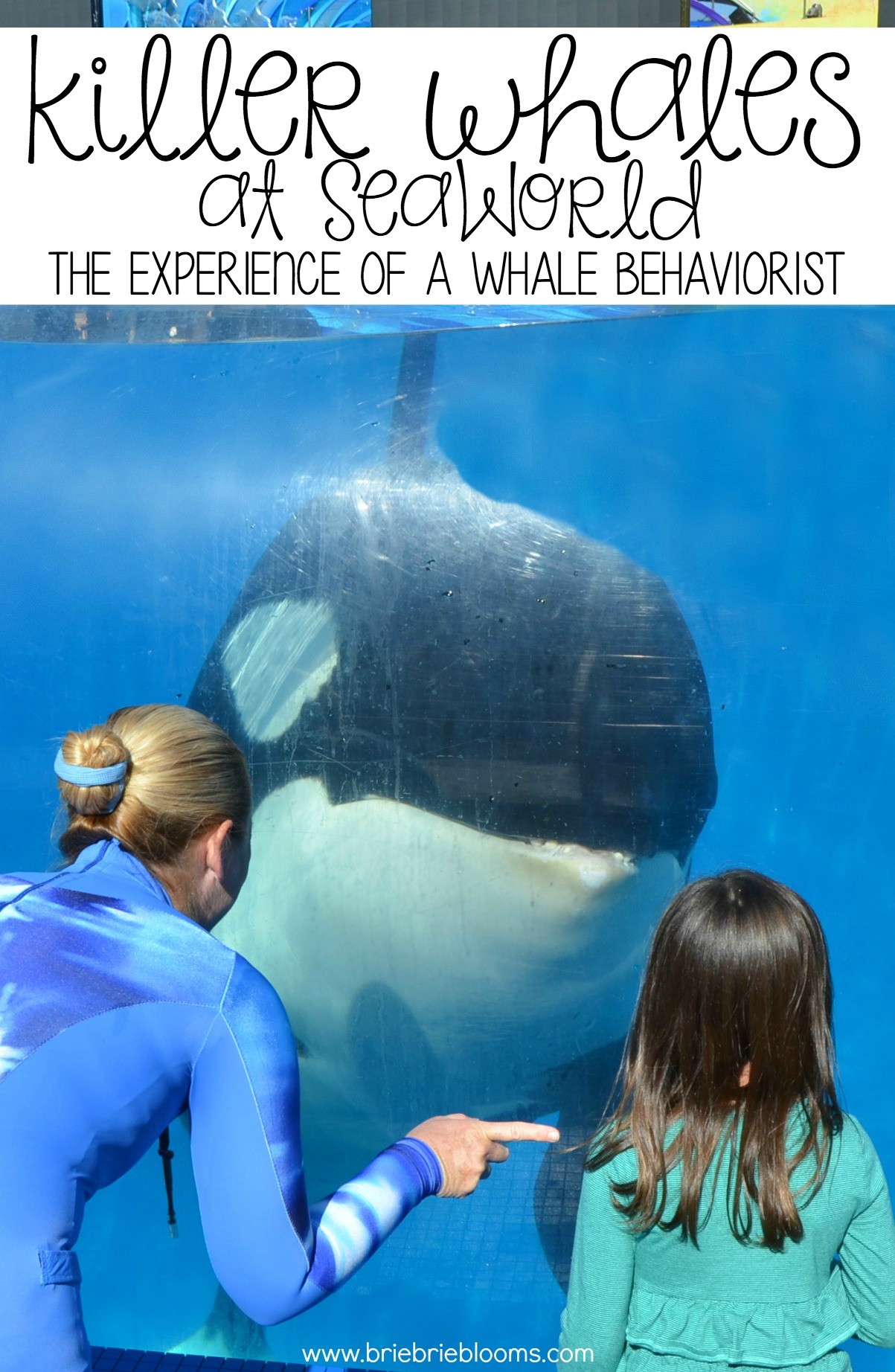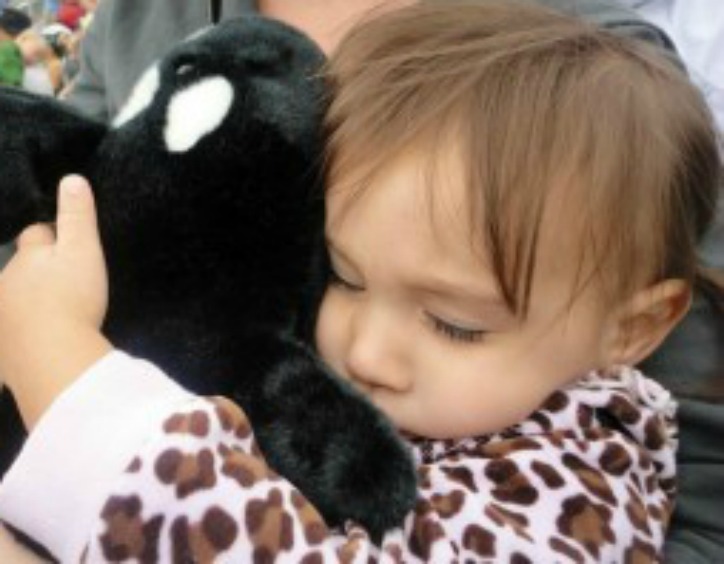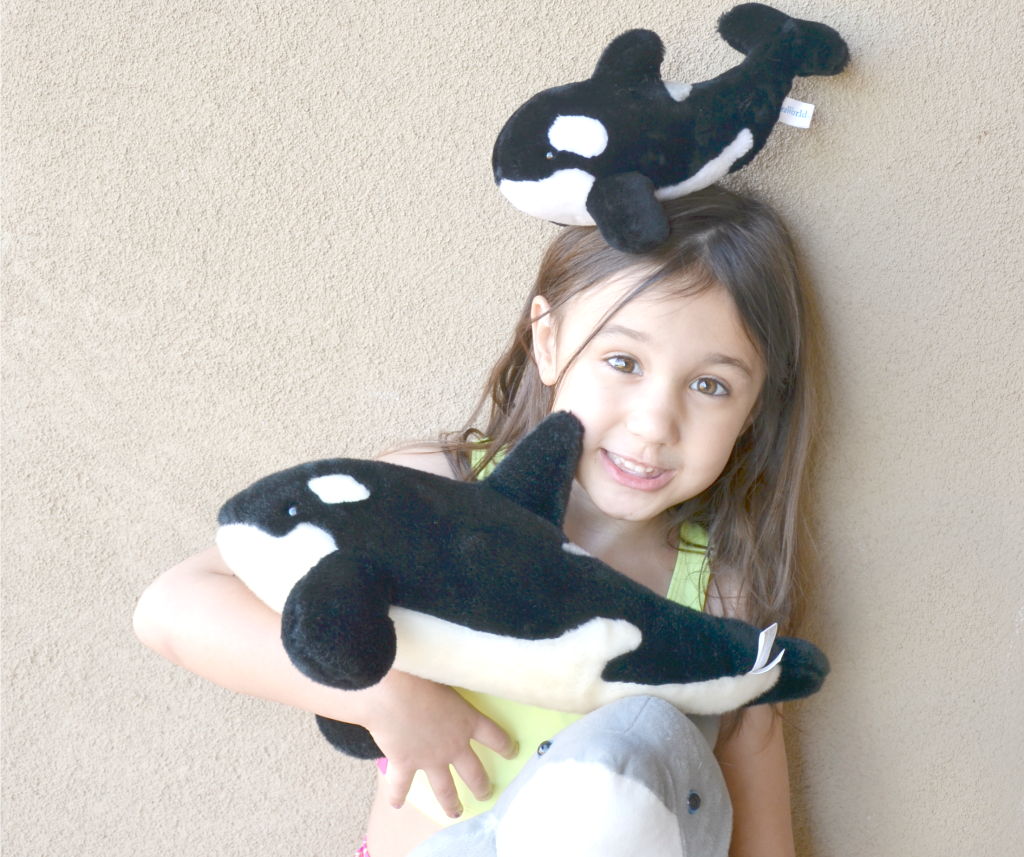I grew up visiting SeaWorld® San Diego with my family. Living in Arizona, far from the ocean, visiting SeaWorld was the only opportunities I had as a child to see and learn about marine animals. As a child I spent time learning about killer whales at SeaWorld so I was elated by the opportunity to spend time with a whale behaviorist and hear her firsthand experience working there.
My daughter looks forward to our frequent SeaWorld visits because she has developed a great interest in marine animals. She enjoys spending a family day at SeaWorld San Diego while learning about sea lions, learning about sharks & cleaner fish, and visiting her favorite animals. She has always been extremely fascinated by the killer whales.
Her very first time visiting the killer whale pool was at just a year old.
During that visit we purchased her first SeaWorld souvenir. She instantly fell in love with her killer whale and cuddled up to it for a nap before we left the park.
photo taken during a family visit to SeaWorld San Diego 2010
Now, at five years old, the stuffed whale is still one of her favorites. Since then she has added a few other marine animals to the collection she sleeps with each night.
I’ve seen firsthand many interactions between the killer whales at SeaWorld and their behaviorists during our frequent visits to the park. The world class standard of care given to killer whales at SeaWorld goes far beyond simply maintaining healthy whales. During a recent visit to SeaWorld San Diego we had the opportunity to talk to Kristi, a whale behaviorist, and learn about her firsthand experience working on the killer whale care team. Her personal account of spending her days forming a close bond to the animals validates everything I’ve learned over my lifetime visiting SeaWorld. The care specialists are passionate about safely caring for the killer whales at SeaWorld.
Constant care, interaction, and observation is provided 24 hours a day and the animals are continually engaged socially, mentally and physically. The killer whales are fed restaurant quality fish and receive extensive monthly health exams. Each behaviorist spends time with the whales to form a close bond and learn the unique behavior patterns of each whale. As expected, we heard firsthand how much genuine care goes into providing a healthy environment for the killer whales at SeaWorld. The close bond we observed between the behaviorist and whale was magnificent.
The behaviorist emphasized the number one priority at SeaWorld is the safety of the animals and staff.
Killer whales live in all oceans of the world but are most common in the icy cold waters of the Artic and Antartic. SeaWorld currently has the largest killer whale population in a zoological facility worldwide. They have not collected a whale from the wild in over 35 years. The SeaWorld scientists have published more than 30 studies benefiting whales in the wild.
Threats to killer whales:
- While healthy adult killer whales have no ocean predators, both natural toxins and human-made toxins can harm killer whales.
- Some pollutants enter the food chain and eventually become concentrated in the bodies of killer whales and other marine predators.
- Oil spills can have long term effects on killer whales.
- Overfishing by humans has caused limited food availability for killer whales in some areas.
- Higher concentrations and closer proximity of whale watching boats can force whales away from their traditional habitats and reduce a killer whale’s echolocation abilities when hunting for prey.
Guidelines for whale watching boats were put in place by the National Oceanic and Atmospheric Administration (NOAA). Impeding the whales’ right of way is not allowed. Chasing, harassing, touching, and feeding animals also are prohibited.
The U.S. Marine Mammal Protection Act (MMPA) of 1972 made it illegal to hunt or harass marine mammals in the U.S.
The Convention in International Trade of Endangered Species (CITES) is an international treaty developed in 1973 to regulate trade in certain wildlife species. Killer whales are listed under CITES Appendix II: species that are not necessarily now threatened with extinction, but that may become so unless trade is closely controlled.
Interesting facts about killer whales:
- At birth killer whale calves are about 7.5 feet long and weigh 300 to 400 pounds.
- Killer whales are powerful swimmers reaching speeds of up to 28 miles per hour.
- The black and white color pattern serves as camouflage and helps the whales hunt their prey. The whales are not recognized as a potential predator by other animals under the flickering filtered sunlight of the sea.
- Killer whale adults eat fishes and squid. In the wild they eat other animals including seals, sea lions, walruses, whales, otters, penguins, and birds.
- Healthy adults killer whales have no natural predators.
- A killer whale eats about 3% to 4% of its body weight in food each day.
Learn more about killer whales by visiting the SeaWorld Killer Whales information page. You can also learn more about killer whales at SeaWorld by taking a Behind-the-Scenes Tour, planning a VIP Expedition Tour, or enjoying a Dine with Shamu experience during your next visit.
To learn more about SeaWorld’s commitment to maintaining their position as a world leader in wildlife rescue and rehabilitation, read the open letter from SeaWorld’s animal advocates. Read why I choose to support SeaWorld if you are interested in our frequent visits to the parks.
If you feel as passionately as I do that SeaWorld provides excellent care for all their animals, are leaders in animal conservation, and are providing abundant educational opportunities, please join the SeaWorld Truth Team to learn how you can stand with SeaWorld.
Connect with SeaWorld San Diego on Facebook, Instagram, and with Clyde the Sea Lion on Twitter to learn more about the park and special events.
Please keep in mind this is a family friendly site and I will not tolerate harassment. Comments will be moderated and deleted as necessary.
Facts about killer whales in this post were collected from SeaWorld printed educational resources for early learners.
Disclosure: Our family received complimentary tickets to SeaWorld and a day full of animal interactions with many learning opportunities for this visit. All opinions are my own.







Incredibly informative. If a whale is capable of swimming at 28 miles an hour is it able to do this at all within the San Diego facility?
Thanks
Thanks Karin. For more information specifically about the behavior of whales at SeaWorld, I’ll refer you back to their site for the most accurate information on their health and daily care. http://seaworldparks.com/en/corporatesites/truth/home/killer-whales/killer-whale-health-and-daily-care/
Kristi has to be one of my favorite trainers. She’s so friendly and passionate. She inspires me to go for my dream of working alongside her with those gorgeous whales one day! I’m happy to be able to call her my friend.